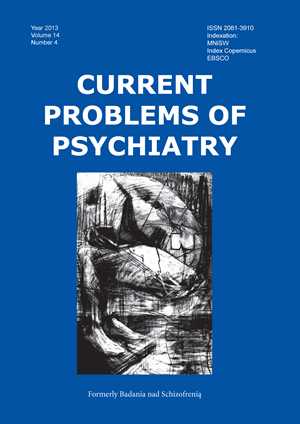Personality functioning of relapse and remission multiple sclerosis patients
Keywords:
multiple sclerosis, personality, self-esteemAbstract
Aim. The aim of this study was to answer the following research question: whether and for what features of self-image there are differences between patients in the phases of remission and relapse of multiple sclerosis?
Participants. The study was carried out in a group of 108 patients with relapsing-remitting multiple sclerosis. The patients' disa-bility score on EDSS (Expanded Disability Status Scale) was 2.13 points and mean disease duration was 4.3 years. The mean age of the participants was 32.3 years. In the course of the study, the patients were on interferon-beta therapy. During that period, they were in remission of multiple sclerosis.
Method. The instruments employed for this study included ACL-37 and a socio-demographic survey designed by the present author. Self-images of patients in the phases of flare-up and remission of MS symptoms were compared using Student's t-test.
Conclusions.
- The actual image of the patients in relapse is more negative than self-image in remission of the disease.
- Patients in relapse are characterized by intensified negative attitude towards themselves; they avoid competition, tend to withdraw from activities aimed at achieving long-term goals and expect quick gratification. Those patients experience greater emotional lability and have impaired control over their emotions. Social interactions arouse in them a strong ambivalence and make them adopt a defensive attitude. The experience of severe symptoms of MS makes the patients focus on themselves.
- Patients in remission of multiple sclerosis, compared with the functioning of patients during exacerbation of MS, are better at identifying and achieving goals, even long-term ones. They have a greater need for achievement. They believe that they work more efficiently. It is easier for them to use their resources and they more effectively cope with the requirements of adult life. They become more sponta-neous. Their need for attention from surrounding people increases. They are better at controlling their emotions and they more strongly seek social contact.
- Both remission and relapse patients tend to seek stability and continuity, and to avoid risky situations. The patients are vigilant and reserved in social interaction. They solicit the support of people whom they consider stronger and more effective in action. They have a sense of personal failure. They view themselves as impulsive individuals who escape from direct experience into the world of dreams.
References
1. Selmaj K. Stwardnienie rozsiane. Poznań: WydawnictwoMedyczne Termedia, 2006.
2. Rzeszutko E., Rolińska A. Radzenie sobie ze stresemu chorych na stwardnienie rozsiane. Curr Probl Psychia-try 2011; 12; 3: 293-300.
3. Gasiul H. Psychologia osobowości. Nurty, teorie, osobo-wości. Warszawa: Wydawnictwo Diffin, 2006.
4. Przetacznik-Gierowska M., Tyszkowa M. Psychologia rozwoju człowieka tom 1. Zagadnienia ogólne. Warsza-wa: PWN, 2011.
5. Pawłowska B., Papuć E. Obraz siebie w okresie rzutu i remisji w postaci zaostrzająco-zwalniającej stwardnie-nia rozsianego (RR-MS). Ann UMCS Lublin Sec D Med2004; LIX, suppl XIV: 334-337.
6. Huflejt-Łukasik M. Ja i procesy samoregulacji. Różnice między zdrowiem a zaburzeniami psychicznymi. War-szawa: Wydawnictwo Scholar, 2010.
7. Selmaj K. Stwardnienie rozsiane. Poznań: Wydawnictwo Medyczne Termedia, 2006.
8. Martowska K. Lista Przymiotnikowa ACL. Harrison G. Gough, Alfred B. Heilbrun, Jr. Polska normalizacja. War-szawa: Pracowania Testów Psychologicznych Polskiego Towarzystwa Psychologicznego, 2012.
9. Papuć E., Pawłowska B. Cechy osobowości pacjentów z postacią zaostrzająco-zwalniającą stwardnienia rozsia-nego (RR-MS). Psychiatr Pol tom XXXIX, nr 4, s. 669-678.
10. Ledwoch M., Borys D. Poczucie zmiany własnej osobo-wości u osób z rozpoznaniem stwardnienia rozsianego. W: Wybrane zagadnienia z psychologii klinicznej i oso-bowości. Problemy człowieka chorego. (red.) Steuden S., Ledwoch M. Lublin Towarzystwo Naukowe KUL, 2005, s. 7-14.
11. Korwin-Piotrowska K., Korwin-Piotrowska T. Obraz sie-bie wśród pacjentów ze stwardnieniem rozsianym. W: Potemkowski A. (red.): Psychologiczne aspekty stwardnienia rozsianego, Poznań: Wydawnictwo Me-dyczne Termedia, 2010, s. 83-90.


